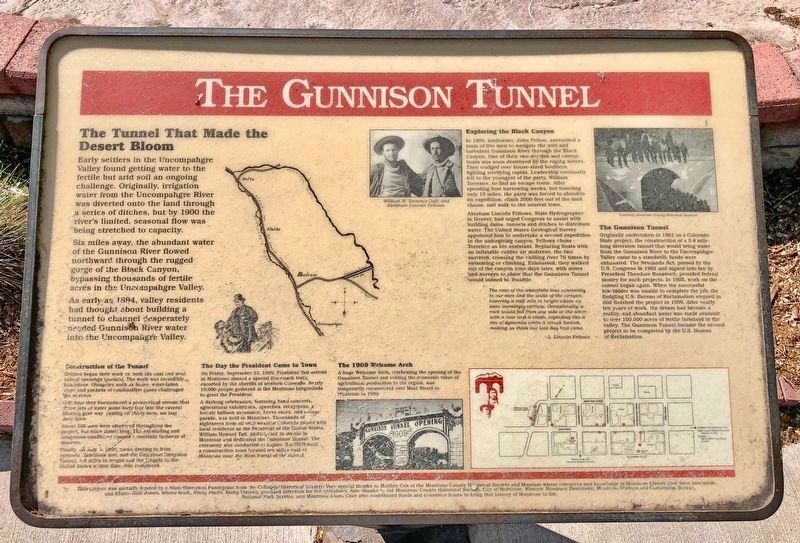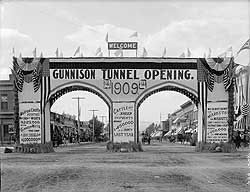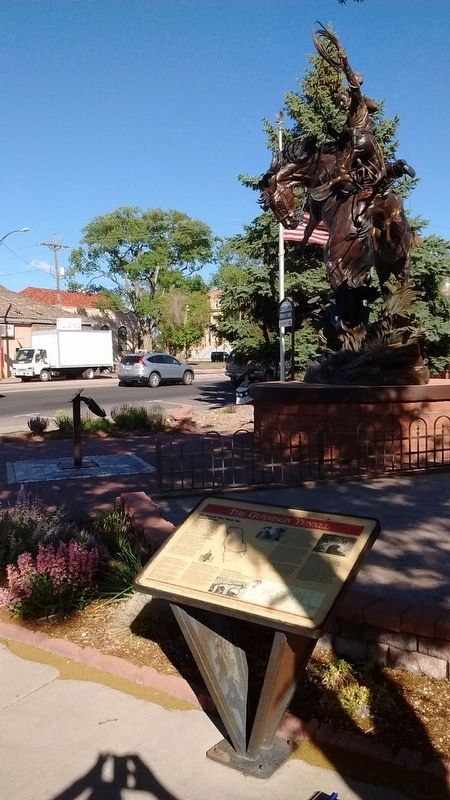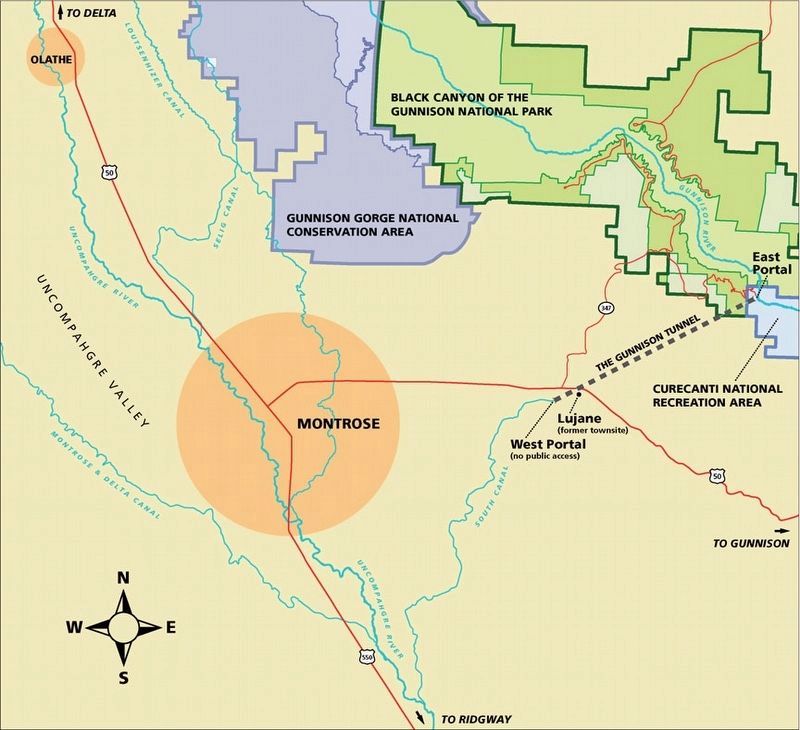Montrose in Montrose County, Colorado — The American Mountains (Southwest)
The Gunnison Tunnel
The Tunnel That Made the Desert Bloom
Early settlers in the Uncompahgre Valley found getting water to the fertile but arid soil an ongoing challenge. Originally, irrigation water from the Uncompahgre River was diverted onto the land through a series of ditches, but by 1900 the river's limited, seasonal flow was being stretched to capacity.
Six miles away, the abundant water of the Gunnison River flowed northward through the rugged gorge of the Black Canyon, bypassing thousands of fertile acres in the Uncompahgre Valley.
As early as 1894, valley residents had thought about building a tunnel to channel desperately needed Gunnison River water in the Uncompahgre Valley.
Exploring the Black Canyon
In 1900, landowner, John Pelton, assembled a team of five men to navigate the wild and turbulent Gunnison River through the Black Canyon. One of their two wooden and canvas boats was soon destroyed by the raging waters. They trudged over house-sized boulders, fighting terrifying rapids. Leadership eventually fell to the youngest of the party, William Torrence, to find an escape route. After spending four harrowing weeks, but traveling only 15 miles, the party was forced to abandon its expedition, climb 2000 feet out of the dark chasm, and walk to the nearest town.
Abraham Lincoln Fellows, State Hydrographer in Denver, had urged Congress to assist with building dams, tunnels and ditches to distribute water. The United States Geographical Survey appointed him to undertake a second expedition in the unforgiving canyon. Fellows chose Torrence as his assistant. Replacing boats with a inflatable rubber air mattress, the two survived, crossing the chilling river 76 times by swimming or climbing. Exhausted, they walked out of the canyon nine days later, with notes and surveys to show that the Gunnison Tunnel would indeed be feasible.
"The roar of the waterfalls was constantly in our ears and the walls of the canyon towering a half mile in height above us, were seemingly vertical. Occasionally, a rock would fall from one side or the other with a roar and a crash, exploding like a ton of dynamite when it struck bottom, making us think our last day had come. - A. Lincoln Fellows
The Gunnison Tunnel
Originally undertaken in 1901 as a Colorado State project, the construction of a 5.8 mile-long diversion tunnel that would bring water from the Gunnison River to the Uncompahgre Valley came to a standstill; funds were exhausted. The Newlands Act, passed by the U.S. Congress in 1902 and signed into law by President Theodore Roosevelt, provided federal money for such projects. In 1905, work on the tunnel began again. When the successful low-bidder was unable to complete the job, the fledgling U.S. Bureau of Reclamation stepped in and finished the project in 1909. After nearly 10 years of work, the dream had become a reality, and abundant water was made available to over 100,000 acres of fertile farmland in the valley. The Gunnison Tunnel became the second project to be completed by the U.S. Bureau of Reclamation.
Construction of the Tunnel
Drillers began their work on both the east and west tunnel openings (portals). The work was incredibly hazardous. Obstacles such as heavy, water-laden clays and pockets of combustible gases challenged the workers.
One time they encountered a pressurized stream that threw jets of water some forty feet into the cavern! Shoring gave way, cutting off thirty men; six lost their lives.
About 500 men were employed throughout the project, but none lasted long. The exhausting and dangerous conditions caused a constant turnover of laborers.
Finally on July 6, 1909, crews drilling in from opposite directions met, and the Gunnison Diversion Tunnel, 5.8 miles in length and the longest in the United States at that time was completed.
The Day the President Came to Town
On Friday, September 23, 1909, President Taft arrived in Montrose aboard a special five-coach train, escorted by the sheriffs of western Colorado. Nearly 10,000 people gathered at the Montrose fairgrounds to greet the President.
A daylong celebration, featuring band concerts, agricultural exhibitions, speeches, receptions, a hot-air balloon ascension, horse races, and a large parade, was held in Montrose. Thousands of sightseers from all over western Colorado joined with local residents as the President of the United States, William Howard Taft, participated in events in Montrose and dedicated the Gunnison Tunnel. The ceremony was conducted at Lujane (Lu-WAH-nuh), a construction town located ten miles east of Montrose near the West Portal of the tunnel.
The 1909 Welcome Arch
A huge Welcome Arch, celebrating the opening of the Gunnison Tunnel and touting the economic value of agricultural production to the region, was temporarily constructed over Main Street in Montrose in 1909.
Erected by Colorado Historical society.
Topics and series. This historical marker is listed in these topic lists: Agriculture • Bridges & Viaducts. In addition, it is included in the Colorado - Montrose - Preserving Our Heritage, the Former U.S. Presidents: #26 Theodore Roosevelt, and the Former U.S. Presidents: #27 William Howard Taft series lists. A significant historical date for this entry is July 6, 1909.
Location. 38° 28.713′ N, 107° 52.67′ W. Marker is in Montrose, Colorado, in Montrose County. Marker is at the intersection of West Main Street and Townsend Avenue, on the right when traveling north on West Main Street. Touch for map. Marker is in this post office area: Montrose CO 81401, United States of America. Touch for directions.
Other nearby markers. At least 8 other markers are within walking distance of this marker. Preserving Our Heritage (within shouting distance of this marker); a different marker also named Preserving Our Heritage (about 300 feet away, measured in a direct line); a different marker also named Preserving Our Heritage (about 300 feet away); What's in a Name? (about 400 feet away); Veterans Memorial (about 400 feet away); Instrument of Surrender (about 400 feet away); Montrose County Jail (about 500 feet away); a different marker also named Preserving Our Heritage (about 600 feet away). Touch for a list and map of all markers in Montrose.
Credits. This page was last revised on October 29, 2020. It was originally submitted on July 14, 2018, by Tom Bosse of Jefferson City, Tennessee. This page has been viewed 473 times since then and 39 times this year. Photos: 1. submitted on July 16, 2018, by Mark Hilton of Montgomery, Alabama. 2, 3, 4. submitted on July 14, 2018, by Tom Bosse of Jefferson City, Tennessee. • Bill Pfingsten was the editor who published this page.



